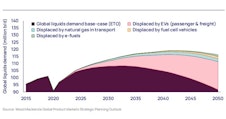
Bestselling science fiction author Kim Stanley Robinson’s novel The Ministry for the Future opens with a deadly heat wave killing millions in India. Written in 2020, it made for grim reading a mere three years later as much of the Northern Hemisphere wilted under record temperatures.
Halfway through the year, 2023 had already registered the hottest June on record, according to a global temperature analysis by space agency NASA. In July, the mercury topped 52º Celsius in Death Valley, US, and hit record highs in Colorado, Nevada, New Mexico and Utah.
Similar temperatures in China saw the country setting an all-time heat record, with records also being broken across Spain and Italy. By the end of July, the extreme heat had sparked blowtorch-like wildfires across at least nine Mediterranean countries, killing dozens and causing massive damage.
Scientists warned that heatwaves are among the deadliest of natural hazards, with poor record keeping masking thousands of deaths every year, and that the unprecedented temperatures seen in 2023, while worsened by the El Niño phenomenon, are almost certainly down to climate change.
Nor is it just the earth that is warming. In July, the surface temperature of waters around the Florida Keys exceeded 38º Celsius—what you would expect in a hot tub. The Mediterranean, meanwhile, was said to be “completely outside all previous records.”
Just as worryingly, an important current called the Atlantic Meridional Overturning Circulation is now weaker than at any time in the past 1,000 years because of global warming, and could stop altogether.
None of this should come as a surprise, with scientists warning in 2022 that the Earth’s biosphere could already have crossed five critical tipping points because of global warming to date.

But even seasoned climate researchers have been caught off guard by the number of records broken and the magnitude of temperature changes in 2023.
Dr Aaron Thierry of Cardiff University said “it's increasingly looking that we've underestimated the impacts of climate breakdown,” while noted environmentalist Bill McKibben said the “crazy” temperatures in Rome “shows we’re living on a new planet.”
There is a growing sense in the scientific community that climate models may have underestimated rather than overhyped the climate change threat.
If so, it is a massive concern for our society, as the nessages so far from the United Nations' Intergovernmental Panel on Climate Change have hardly been comforting.
Once we start hitting tipping points, we could be on a path of no return in which the foundations of the economy start to break down. In 2015, Axa chairman Henri de Castries warned that a “A 2° Celsius world might be insurable; a 4° Celsius world certainly would not be.”
The good news is that the solution to the climate problem is obvious.
As scientists—including those working for oil companies—have been warning for decades, global warming is directly linked to greenhouse gas emissions, so cutting levels of atmospheric carbon dioxide and methane should help return things to normal.
The bad news is that cutting emissions seems easier said than done, which is why we are seeing a drastic worsening of climate—and increasingly frantic calls from the research community.
Friederike Otto, of the Grantham Institute for Climate Change, Imperial College London, warned in 2022 that "if carbon emissions are not rapidly cut, the consequences of climate change on extreme heat in Europe, which already is extremely deadly, could be even worse than we previously thought.”
He spoke as global energy-related carbon dioxide emissions reached a new high of 36.8 gigatonnes, rising everywhere in the world bar China and Europe, according to the International Energy Agency (IEA).
In 2021, the IEA noted that emissions could continue on an upward trend through 2023 as only 2% of COVID-19 recovery spending was going into energy transition investments. The trend seems likely to continue while there is fierce demand for oil and gas.
Worryingly, analyst firm Wood Mackenzie predicts demand for oil will continue to rise until the early 2030s, when it could hit 108 million barrels a day. Oil and gas companies could invest $500 billion a year in upstream operations until well into the 2030s, Wood Mackenzie believes.

Furthermore, much of the new production being unlocked by this investment could be in highly polluting reserves, Wood Mackenzie says.
“The energy transition will require oil and gas for decades to come, but the supply of lower-cost, lower-carbon ‘advantaged’ barrels remain scarce, threatening emissions targets,” says the analyst firm.
Against these major headwinds, the only option is to double down on greening the energy system. Critics may argue that changing the system too quickly might endanger the economy, but the opposite increasingly seems the case.
Without rapid decarbonisation, a fast-deteriorating climate will threaten supply chains, harm productivity and put geopolitical stability at risk as millions of refugees abandon hard-hit areas.
Meanwhile, the path to green just looks more and more attractive from an economic point of view.
Wind and solar are already the cheapest forms of new generation in most parts of the world, and at Pacific Green we have shown how investors can make excellent returns from cleantech assets such as battery plants.
Longer term, analysts forecast massive returns from emerging low-carbon markets. The electric vehicle market, for example, could be worth almost $952 billion by 2030, according to Markets and Markets, after seeing a compound annual growth rate of nearly 14%.
Similarly, IDTechEx predicts the market for low-carbon hydrogen could be worth $130 billion by 2033, based on projected production capacities. As the climate worsens, it clearly makes financial and environmental sense to accelerate such investments as fast and as far as we can.
In The Ministry for the Future, a fraught humanity resorts to desperate acts of geoengineering and global terrorism to prevent a climate catastrophe. In real life, we still have a chance to avoid such extreme measures, but the window of opportunity is closing.
The grim lesson from 2023 is that we may have much less time to act than we think.
Publish date: 09 August, 2023